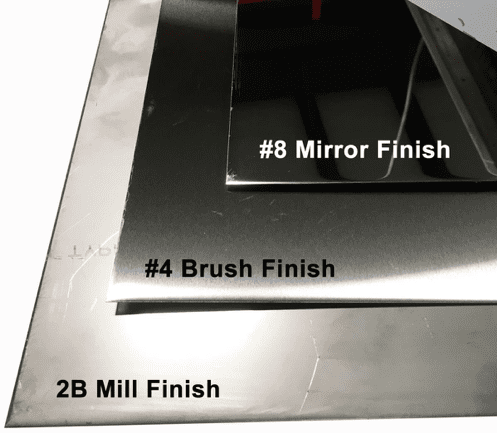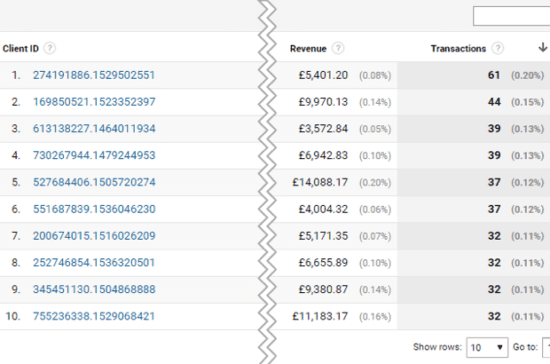Optimize your PPC campaigns for technical industries, target markets and order size
When anyone talks about e-commerce, the focus is often on B2C. They use examples of fast fashion or basketball shoes. However, there is a whole industry out there dedicated to selling businesses’ materials that they need to do their job. Whether it’s scissor lifts, aluminum sheeting or palisade fences, there are companies selling them and companies buying them. Marketing a B2B store in these industries often comes with several unique challenges.
Challenge – extremely technical industries
Do you know whether mirror polished or circle polished sheet metal is the same thing? I didn’t until I had to market it and work out whether our products qualified for either activity. As a marketer, we need to know the products we market as well as the people we’re trying to market them to. That means research – a lot of it.

Common stainless steel sheet finish types for the curious-minded amongst you
Of course, there’s no better fountain of knowledge about the products than your client. Questioning them regularly about whether certain search queries match the product is an excellent idea. However, it’s usually advised to have a decent base level of knowledge as well in order to not have to go back to the client every five minutes.
For that reason, I typically spend a good few hours when I get a new client just improving my knowledge on the subject. Wikipedia may not be the greatest academic source but it can do wonders for your surface level understanding. Of course, there are many more methods for advanced researching.
The extremely technical nature of the industry can come in handy, however. It often manifests itself in some very specific search queries as professionals know exactly what they’re looking for. In particular, queries involving exact dimensions or obscure terminology are very common. Therefore, intricate structures are quite well advised here so you can match your keyword and ad copy as closely to the user search as possible.

Here we set up ad groups to target each thickness of Aluminium Sheet the client sold, with ads to match. The combined ROAS from these ad groups was over 3x that of the original generic ad group. This lead to an overall ROAS increase of 45%.
Challenge – target businesses, not people
All B2B marketers wish there was a way to only target people searching as their company, but alas the machine learning isn’t there just yet (the exception to this is Amazon where you can target business accounts). Instead, we have to deal with the fact that there are so many more consumers out there searching than businesses and it’s important to cut through the noise to hit the right searchers.
Step one is to know your B2C competitors vs B2B competitors. You’ll want to exclude all of your B&Q or Wickes type shops from your campaigns with negative keywords, but other businesses that you more directly compete with you should absolutely target. Finding professionals is hard and they’ve already done the work, so why not try to steal them where you can?
Of course, when you yourself have already found the professionals, it’s even better. There’s a much lower expectation of privacy when working on behalf of a business so you can get quite aggressive with your retargeting on past users. In particular, looking at what the typical buying cycle is and hammering users in that time period can often be very profitable.
Mobile first may be the rallying call across the web, but in the B2B e-commerce arena, desktop remains king. Across our accounts, on average 65% of sessions are originating on desktop, with over 85% of revenue. This corresponds to a Per Session Value over five times or in some cases ten times higher on desktop than mobile. It turns out most professionals are still using a PC to make big purchases. For some reason, nobody is purchasing 2km of temporary fencing by voice search yet…

Maybe don’t put positive mobile adjustments on this account, no matter what Google tells you about user behaviour.
Finally, Similar To audiences are a great way of expanding your limited Customer Match audiences to try and find other businesses you might be able to bring into the fold. In particular, a strategy we’ve found a lot of success with is placing a low bid on more generic keywords that we’d normally associate with consumers e.g. steel sheeting. If we then put large bid modifiers on our Similar To audiences we can ensure we have good visibility for businesses but not waste money on consumers.
Challenge – optimizing for large orders
With B2B e-commerce more than anywhere else, you’re going to encounter the Pareto Principle a lot. As we can see from the below charts for this client, over 80% of their revenue comes from orders over £1,000 which account for a mere 25% of total transactions (the largest single order was £9,500).

This comes with a lot of difficulties. As you’re reliant on these rarer large orders you will see a lot of variation in your performance week to week. It is therefore important to always look at the bigger trends and not get too caught up in small timescale variations. Two large orders one week and none the next does not mean the account is failing. Whenever you’re presenting results to clients, try to be aware of whether there was consistent good performance or one huge sale.
Now while optimizing for the keywords that bring in the large orders is a valuable strategy, it is important not to fully exclude the small orders too much from your marketing. Think of them as upper funnel transactions. It’s rare that a company is going to commit to a huge order from a company they’ve not got a good relationship with. But if they’ve bought the odd thing in the past they’re much more likely to commit to a large order in the future.
Whilst B2B e-commerce is no SaaS, it does share a lot of similar attributes. You have users coming back and again for repeat purchases as they need fresh supplies to continue their work. Therefore, when judging initial acquisition costs, especially with small orders, always try to take account of the probability for repeat purchases and optimize for Life-Time Value. When including these calculations you’ll find that you can tolerate much more expensive acquisition costs, which will allow you to outbid your competitors and gobble up that market share.

Some businesses will just keep coming back for more and more. Hooking the whales is a great way to secure long term revenue goals.
Conclusion
While B2B e-commerce can be very challenging it can also be very rewarding when it works out. In general, it’s a middle ground between the pedal to the metal world of B2C and the “maybe you’ll see if your campaign was successful in two years” world of B2B lead gen. It lets you know what’s working now while being safe in the knowledge that your wins now will proliferate in the future.